Iris Kensmil Paints the Reach and Richness of Black History
Iris Kensmil has always been surprised how little the Dutch know about colonial history, the black struggle for equal rights, the art and the ideas of the region where her Surinamese parents come from. And so, the artist portrays advocates of emancipation, in order to dismantle stereotypes about women and people of colour. After representing the Netherlands at the Venice Biennale, Museum Kranenburgh in Bergen is now presenting an exhibition of her work: Blues Before Sunrise.
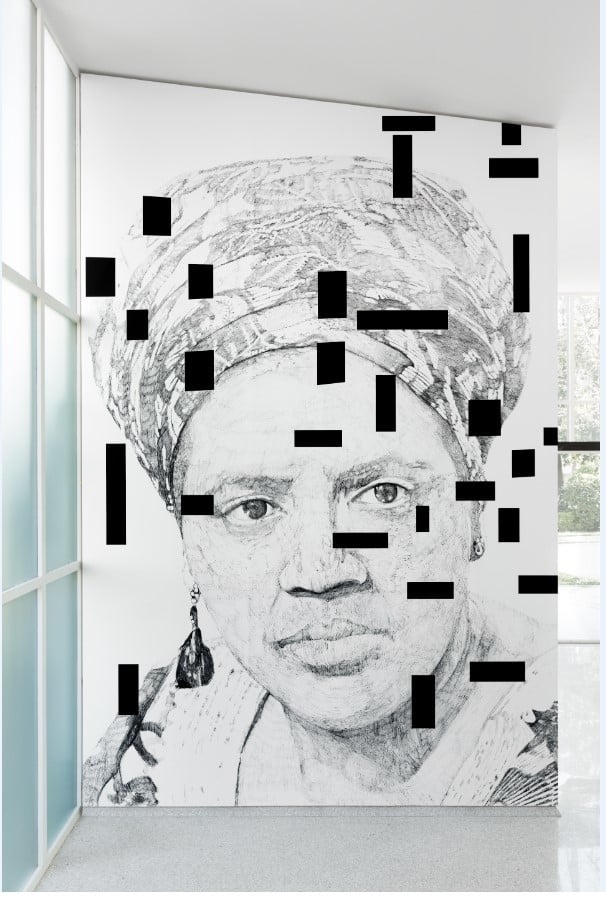 The New Utopia Begins Here #2, inkt en acrylverf op muur, 2019
The New Utopia Begins Here #2, inkt en acrylverf op muur, 2019© Gerrit Schreurs
The woman’s eyes regard the viewer in an inquisitive and inviting manner. She wears a headscarf. It is a portrait of the Caribbean-American writer and activist Audrey Lorde (1934-1992). Spanning several meters, the image by Iris Kensmil has been painted in grey tones, straight onto the white wall, combined with horizontal and vertical black cubes. Lorde is one of eight women that Kensmil painted under the title Black Utopian Feminists (2018-2019).
With this series Kensmil brings women onto the stage that – except for a few – have disappeared into the folds of cultural history, at least in the Netherlands. Kensmil’s choice to represent these black feminists, has been inspired by their ‘visionary’ points of view. The series can be seen at the Rietveld Pavilion in Venice’s Giardini until mid-November 2019, where Kensmil, together with Remy Jungerman, represents the Netherlands this year. For the first time in the history of the Dutch pavilion, an artist has changed common perceptions of modernism by bringing tribute to black feminism. One critic branded the portraits jokingly as instant-icons, another mentioned Kensmil in her top 10 Venice picks and predicted that her achievement would drastically change the way we regard the colonial past, nationalism and modernism.
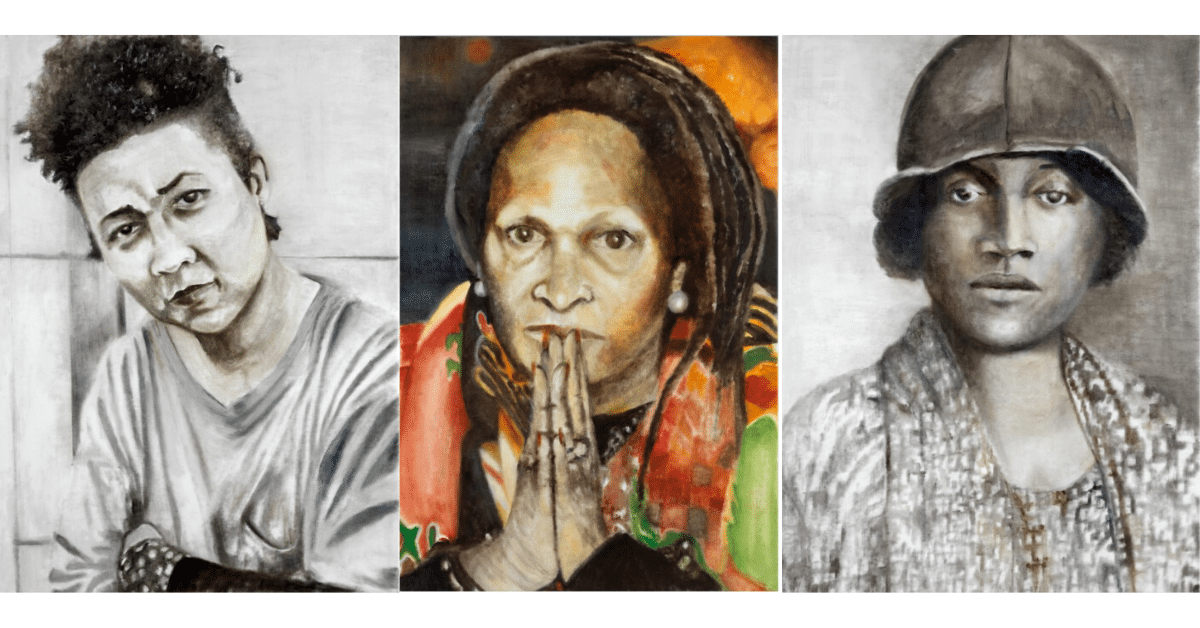 The New Utopia Begins Here: bell hooks, Sister Nancy and Amy Ashwood Garvey
The New Utopia Begins Here: bell hooks, Sister Nancy and Amy Ashwood Garvey© Gert Jan van Rooij
Besides Audrey Lorde the exhibition features portraits of journalist Claudia Jones (1915-1964), science fiction writer Octavia Butler (1947-2006), the anti-colonial, surrealist writer Suzanne Césaire (1915-1966), the communist and activist freedom fighter Suriname Hermina Huiswoud (1905-1998), the publicist Amy Ashwood Garvey (1897-1969), dancehall DJ and singer Sister Nancy (1962) and theorist bell hooks (1952).
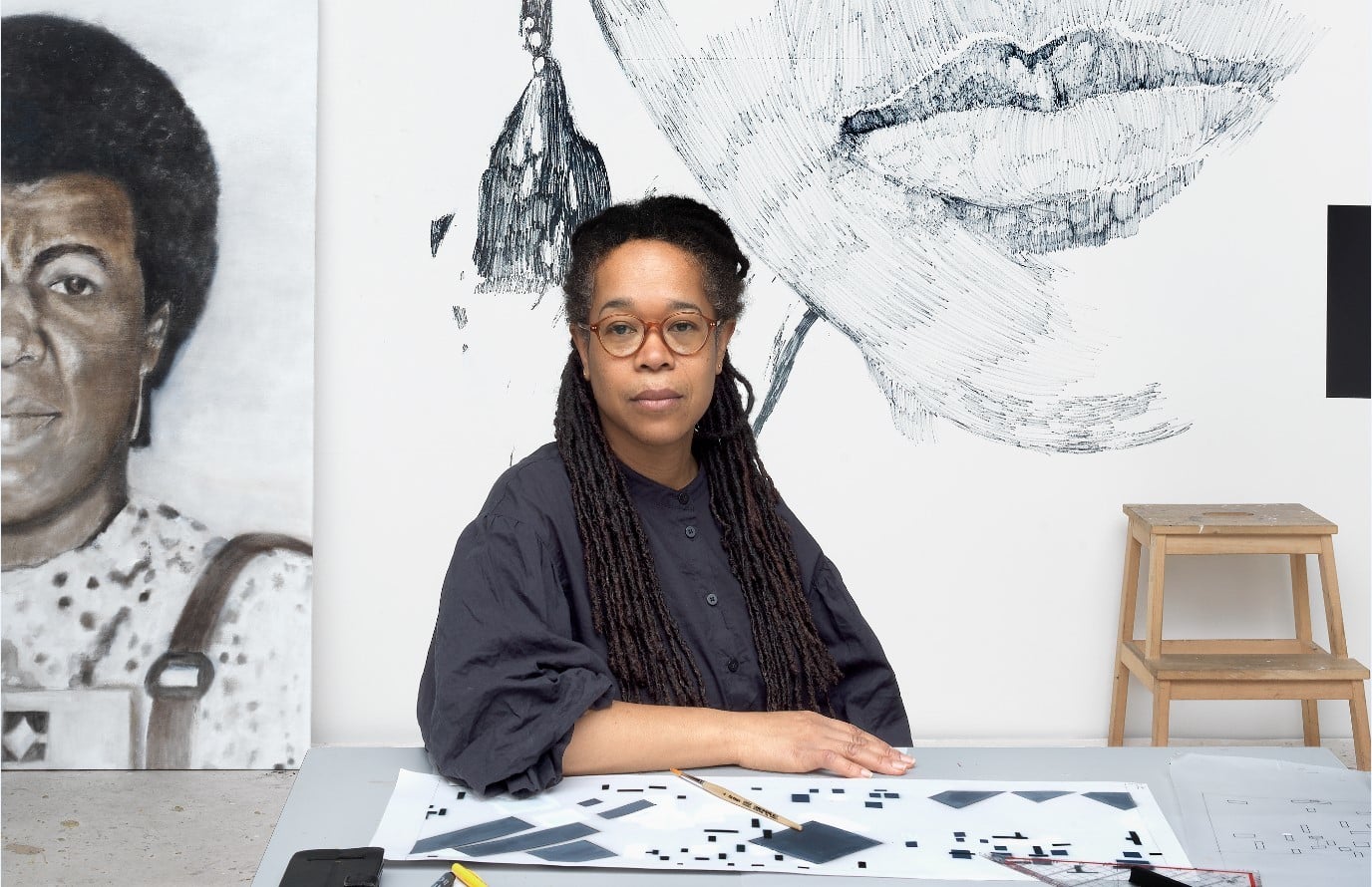 Iris Kensmil
Iris KensmilKensmil portrays them with light greys or sober colours, using internet images from these ‘black feminists’ as a point of departure. She integrated these photo-realistic portraits into two monumental, abstract murals. Their composition features horizontal, vertical and diagonal blocks and squares in grey and black that bring to mind the works of modernist artists such as Piet Mondrian, Theo van Doesburg and Kazimir Malevitsj.
Lack of recognition
Featuring titles such as The New Utopia Begins Here #1 and #2, Kensmil explicitly references the assumed progressiveness of Western modernism with its promises of progress, freedom and universal equality. By adding women’s faces to the schematic composition the artist emphasizes the lack of recognition for black intellectual and activist ideas, particularly those of women.
In doing so, Kensmil enables audiences to see both through her eyes and through the eyes of the women portrayed, in order to change how modernism and the world are perceived. Her feminists are not portrayed as stereotypes, sexual objects or nameless servants, are not depicted as victims or counterparts to the iconic, combative figure of Aunt Jemima’s mammy/maid, but as women who demand respect by virtue of who they are and their intellectual, literary and musical achievements. On the one hand Kensmil seems to want to pinpoint black female agency. On the other she’s showing the ‘partiality’ in how modernism and modernity are often approached. ‘Modernity has a much richer history than is generally known, and in Western black movements it has developed differently.’ In Eurocentric accounts of modernist history, the contribution of black intellectuals is systematically ignored, and this includes women. ‘That is why I am supplementing history with black female utopias’, says Kensmil.
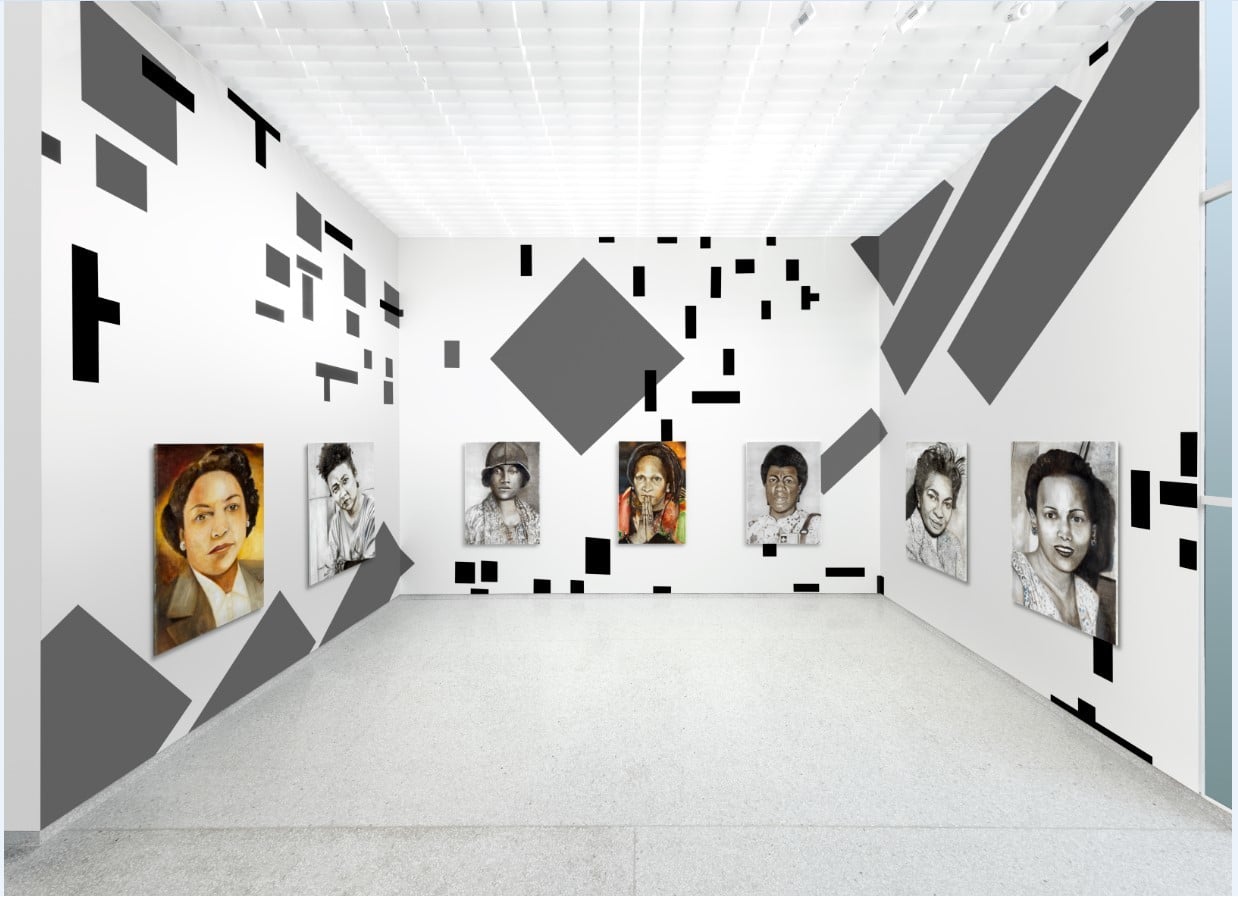 The New Utopia Begins Here #1, 2019
The New Utopia Begins Here #1, 2019© Gerrit Schreurs
‘Kensmil pushes us to reconsider the canon of art history, not from a national or historical perspective, but from one that includes the myriad voices of Black counterculture and the intellectual propositions that have challenged the hegemony of white modernism’, writes art historian Nick Aikens in the Biennial’s catalogue. In the words of theorist Walter Mignolo, as quoted by Aikens: ‘Modernism is a complex narrative that originated in Europe and celebrated its achievements while at the same time covering up its darker side: colonialism.’
Not only through her subject matter but also from a stylistic point of view Kensmil connects the Eurocentric canon of art history with that of black female counterculture; the soft yet expressive lines in her portraits are in stark contrast with the tightly controlled, abstract shapes in the murals, as fellow artist Willem de Rooij remarked in the catalogue. Notwithstanding their engaging nature, these images express a distinct feeling of worlds colliding. There is a sense of disconnect.
Bicultural background
What her female subjects have in common is that they each have influenced discourses on modernism and exclusion, gender relations, black identity and culture, and – except for a few – they all have roots in the Caribbean, Suriname or British Guyana. The latter is not a coincidence. Kensmil, born in Amsterdam, grew up in Paramaribo until she was nine, after which she lived in Amsterdam with her Suriname parents and sister.
It has always surprised her how little is known in the Netherlands in terms of colonial history, the black equality movement, or the art and culture from her parent’s homeland. At the same time, she is critical of those instances when her own bicultural background is brought into direct, reductive relation with her work. This is what her third mural in the Rietveld Pavilion represents. Beyond the Burden of Representation features, again against a backdrop of black cubes, a bookshelf and five paintings. With it, Kensmil offers tribute to the artists she admires: because of their work and because they managed to keep public reception of their work separate from their personal background. In a recognizable manner she represents the typical work of Adrian Piper, Charlotte Posenenske, On Kawara and stanley brouwn.
 Beyond the Burden of Representation, 2019
Beyond the Burden of Representation, 2019© Gerrit Schreurs
For those who have followed Iris Kensmil the past few years her choice for portraiture won’t come as a surprise. Neither is her choice to depict subjects who have distinguished themselves through their activism, publications or music, and who have fought for black emancipation. Ever since 2003, Kensmil has become known for uncovering black histories and cultures, be it by representing the Civil Rights movement in America, the Marron leaders in Suriname, or inspiring figures from the world of music.
Her work diverges from fictional approaches to representation operated by, for example, the British artist Lynette Yiadom-Boakye, whose black subjects are depicted as part of daily life and within a timeless universe. Instead, Kensmil portrays people whose history she knows and is invested in. Her characters are permeated with agency, often depicted frontally, with postures and expressions that reflect a certain degree of activism and resistance. Often this effect is emphasized through the application of text onto the image itself, or directly onto the wall using templates.
Turning point
From 1992 until 1996 Kensmil studied at the Minerva Academy for the Arts in Groningen, where emphasis is put on technical painting. She experiences first-hand the tail-end of the visionary crisis that has been debated for years in art academies and the fine art world, or more precisely the debate on realism versus abstraction (a battle that now, twenty years later, has become obsolete).
Post-graduation, she initially chooses abstraction, painting coloured planes with many layers. Inspired by the American painter Jasper Johns she starts to introduce text to the works. From within the crude layers of paint emerge words like Bruce or Up, up, you mighty race, filling the entire visual field and instilling a certain sense of narrative in the abstract scenery. They are written in a helpless, careless script and resemble a cry for help. Art critic Sandra Smallenburg describes them in her 2003 review as grim and emotional: “Repeat the words often enough and they burst from the canvas like a verbal castigation”.
In the painting Negroes (are oké) Kensmil investigates the limits of the word ‘negro’ which, in common discourse, is charged with racist meaning. The work is made up of drab fields of colour from which, in pink, the words ‘niger’
and ‘negos‘ appear. By virtue of the intentionally bad spelling and the pink colour the significance of the word becomes destabilized. Retrospectively, the work signals as a turning point in her career.
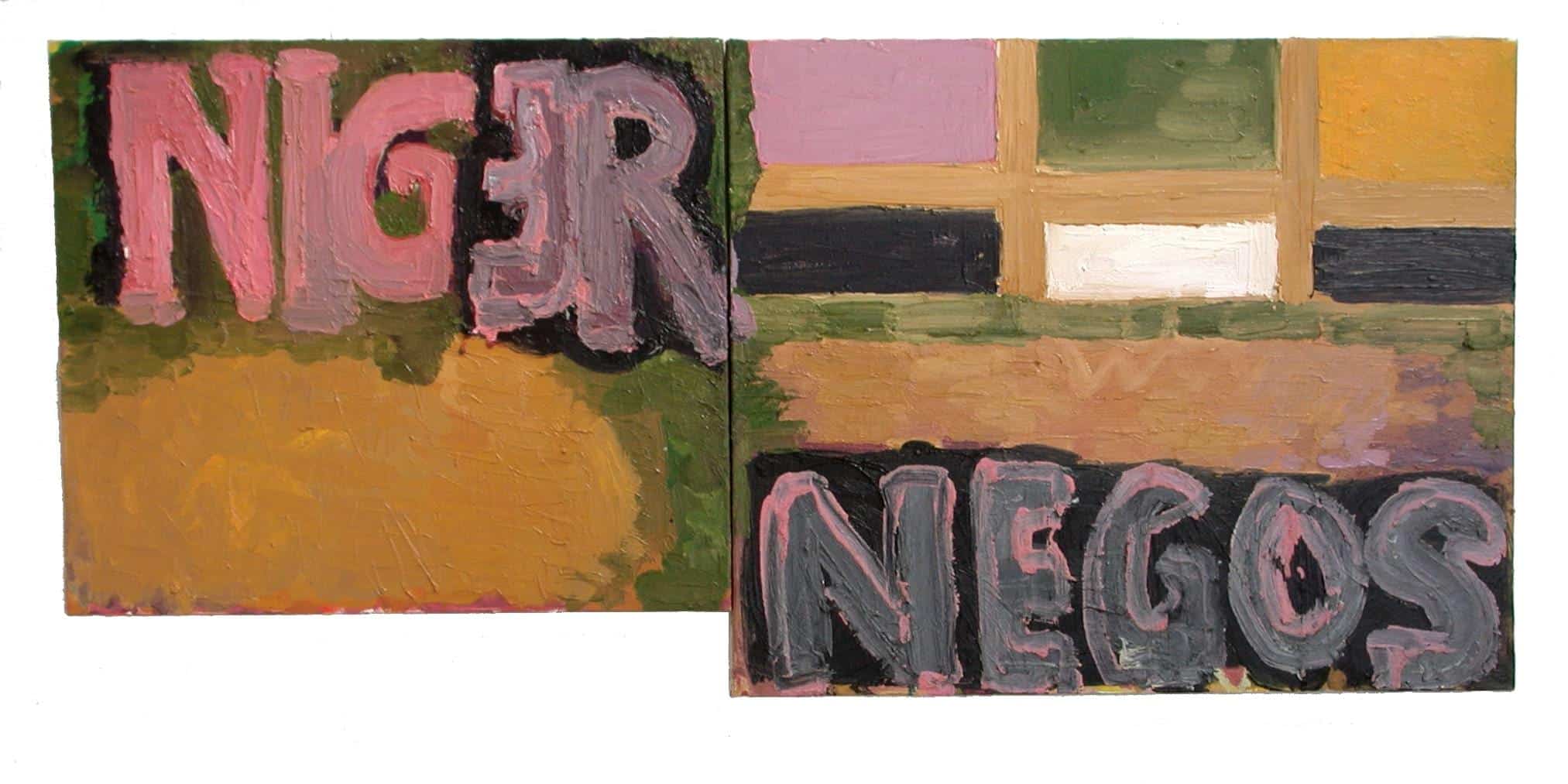 Negroes [are oké], 2000
Negroes [are oké], 2000© private collection
The painting was made in 2000, the same year that Kensmil returns to Suriname to visit her family. After this trip her work changes direction: abstraction is joined by figures, sometimes combined with text. In her search for her ancestral history and suppressed memories, colourful drawings of her substantial family emerge, based on photographs that feature the artist amongst her grandparents, uncles, aunts, nieces and nephews in Paramaribo, combined with dairy-like entries. The typical slatted structures of Paramaribo’s wooden houses return as horizontal and vertical patterns in paintings like Hope to see you soon (2004). Increasingly Kensmil incorporates orange, yellow, red, green and brown; colours that remind her of the place where she grew up until she was nine years old.
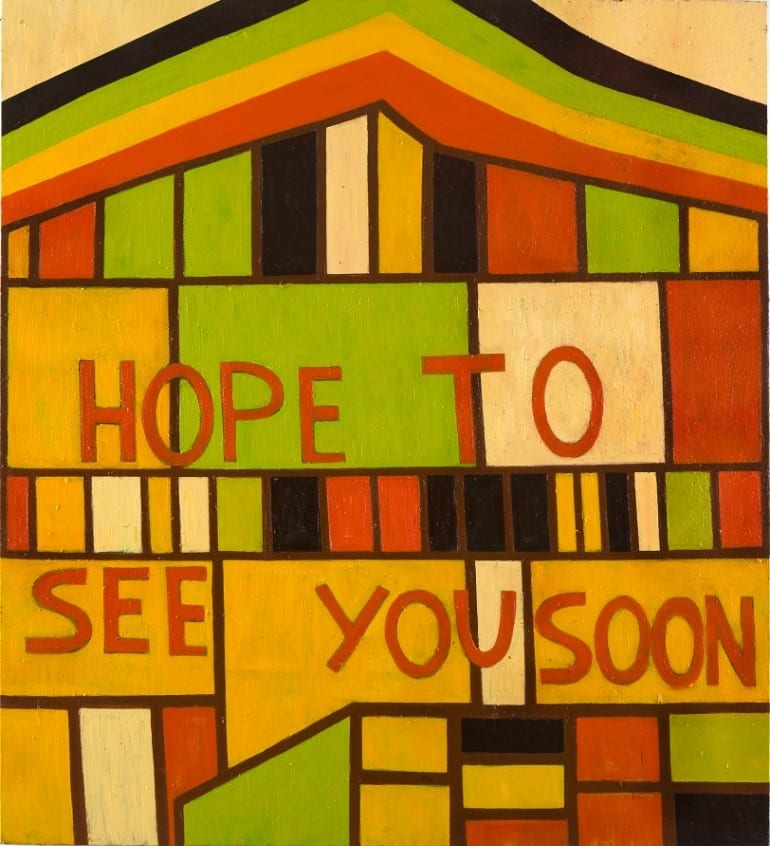 Hope to see you soon, 2004
Hope to see you soon, 2004© Gert Jan van Rooij
When giving increasingly more space to her own experiences it made sense to depict black figures, says the artist. She also feels a growing need to deepen her understanding of ‘black consciousness’ and the history of black emancipation. Ever since, these subjects have formed Kensmil’s key themes. Following the American art historian Kellie Jones this turning point could be called a strategy of reterritorialization. Jones used this term in 1990 to label the tendency amongst many black female artists to question and redefine ingrained and stereotypical representations of women and race. Reterritorialization, according to Jones, is the return to and ‘appropriation of your own, and other histories that have endured as a footnote of dominant culture.’
Black emancipation
Kensmil starts her reterritorialization process by collecting reproductions of icons that played an important role in the American Civil Rights movement, as well as in the battle against discrimination and violence in the sixties, amongst whom we find Martin Luther King, Marcus Garvey, and Malcolm X and Huey Newton of the Black Panther Party in America. In these paintings, such as The Great March (2004) portraits appear combined with textual references to the Washington D.C. protest march, where Martin Luther King addressed the crowds with his legendary I have a dream speech in 1963.
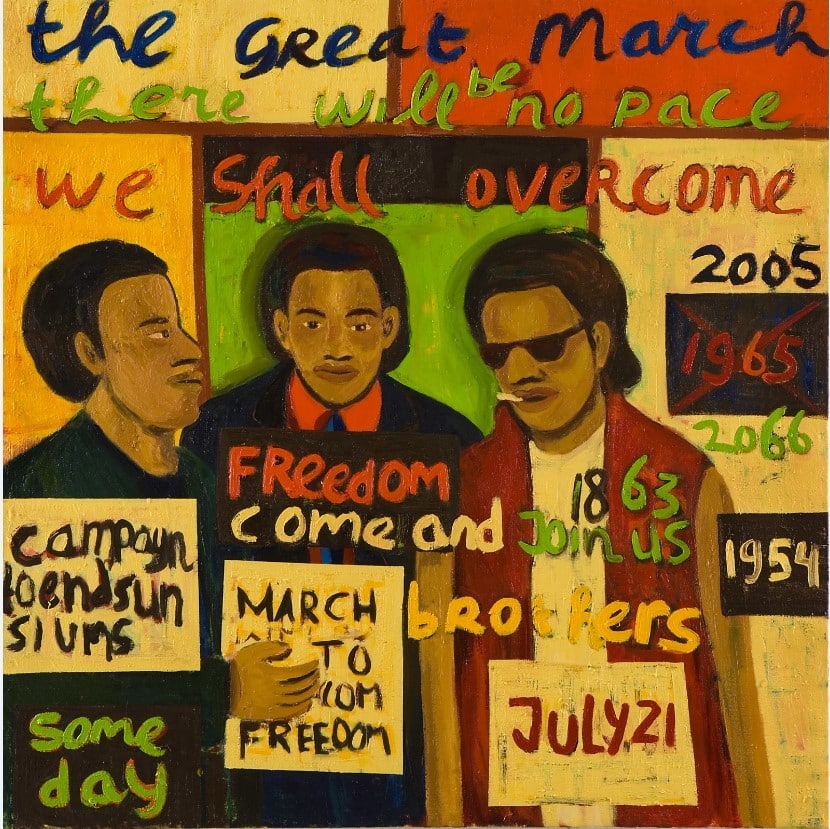 The Great March, 2005
The Great March, 2005© Gert Jan van Rooij
A few works bring to mind the works of African-American artists that critically engaged with racism and sexism in the sixties through the use of style, text and subject matter. They represent important advocates for the Civil Rights movement and the Black Panther. For example, Kensmils Any Getting It (2004) shows four female members of the Black Panther Party as they raise their arms in a militant gesture while opening their mouths in a battle cry.
Asides from depicting prominent figures from the historic black emancipation movement, the artist also depicts figures from intellectual and literary worlds that may have played less of a public role but are influential in other ways. An apt example of the ways in which Kensmil incorporates different sources of inspiration are two installations from 2005. In Marrakesh she installed House of Day Dreams, a work that can be interpreted as a homage to African, African-American and Caribbean writers, amongst whom Ben Okri, Ken Saro-Wiwa and Maryse Condé. Thirteen portraits have been placed against a colourful backdrop of vertical and horizontal lines, reminding us of those typical Surinam wooden fronts. On the floor, in front of the large canvas, lie stacks of books by these authors.
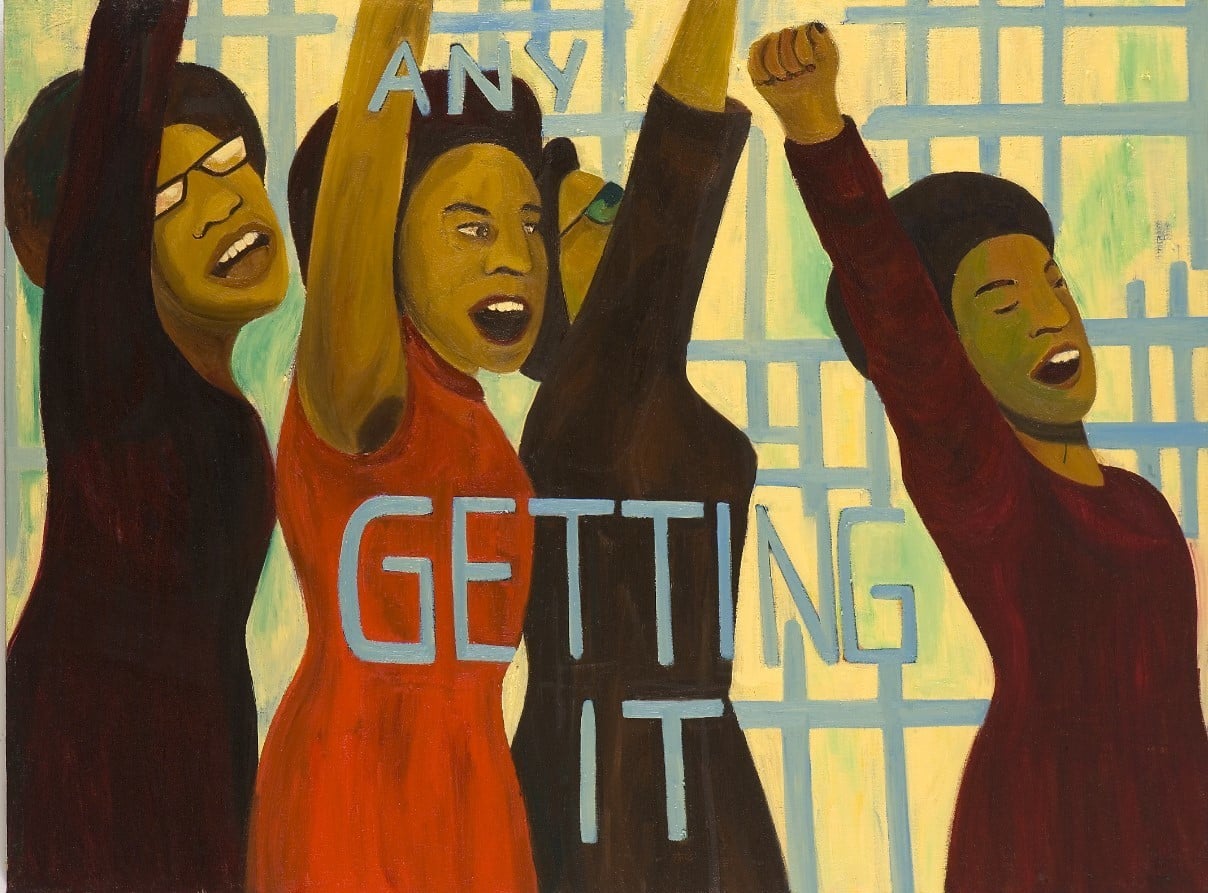 Any Getting It, 2004
Any Getting It, 2004© Collection Museum Het Valkhof, Nijmegen
Another installation, Free Free at Last, which was presented that same year in Arti & Amicitiae in Amsterdam, depicts figures of American black emancipation movements and African independence movements. Portraits of Angela Davis, Patrice Lumumba and Nelson Mandela are hung against a map of former American slave states. A monumental painting of the African continent is hung on the adjacent wall. Over it, in large upper-case letters, world spell out A Dream Of. Noticeable are the swings that are hung freely in the space and through which Kensmil connects the fight for independence and equality in other continents to the history of Suriname; they are the typical wooden stools made by the Marrons in Suriname.
Doing away with taboos
As optimistic as Kensmil is about her recent professional developments, she can’t help but notice a resistance against her themes and her conscious choice to depict only black figures. It is as if she’s broken a taboo, according to the artist. Asides from positive appreciation she has been accused of pamphleteering. Following a monumental 2007 mural at the American artist initiative W139 visitors and fellow artists wondered why she combined texts such as we want to determine the destiny of our black and oppressed communities with scenes featuring ‘only black people,’ because ‘that is not an issue in the Netherlands’. She takes theses critical admonishments as encouragement. Strengthened by the oeuvre of inspiring artists such as Kerry James Marshall and Kara Walker she decides to maintain direction.
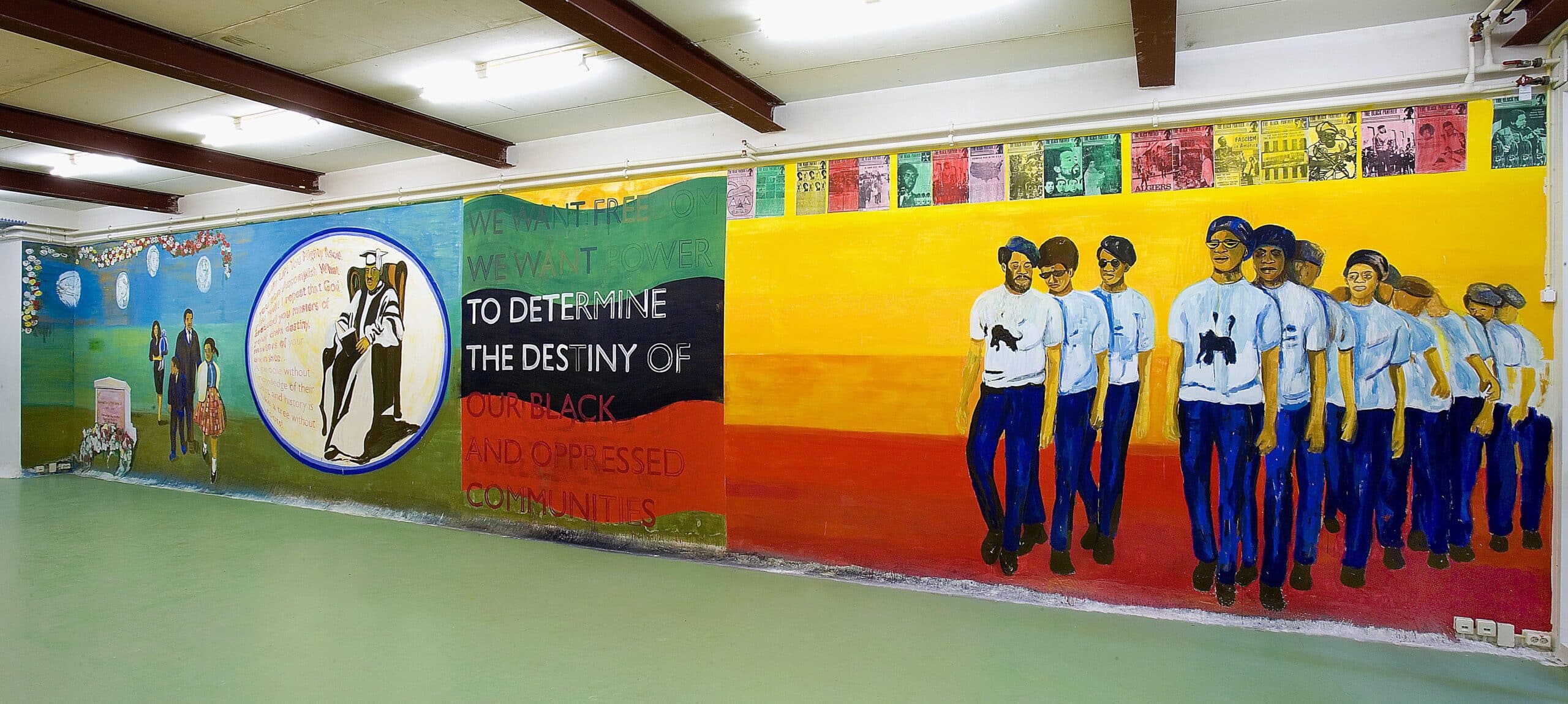 To determine the Destiny (detail), 2007
To determine the Destiny (detail), 2007© kunstenaarsinitiatief W139, Amsterdam
She experiences a very different taboo during the instalment of the exhibition project Wakaman in 2009, initiated by artists Remy Jungerman and Gillion Grantsaan in Paramaribo. Taking place inside of the infamous Fort Zeelandia Kensmil, together with young Surinam artist Kurt Nahar, pays tribute to the fifteen victims that were executed here, at Desi Bouterse’s former headquarters, during his militant regime in 1982. Kensmil herself remembers the oppressive atmosphere at the time, which she experienced during a visit to her grandfather. The December Murders left deep traces in the Surinam community. Many are afraid to speak about it publicly, even today.
Kensmil exhibits portraits of the victims together with historic Surinam postcards, including their names and forensic descriptions of their beaten-up bodies on the back. On the eve of the Wakaman opening she is told that people are worried about the tribute’s consequences. Kensmil and Nahar decide to persist. During the opening visitors respond emotionally; after more than 27 years this fatal reckoning with voices critical of the regime, covered up in everyday discourse, becomes part of an artistic context against the backdrop of, notably, the original crime scene.
In the work that follows it is clear that Kensmil increasingly chooses topics that are related to the history of Surinam, the history of her ancestors.
The wake of history
In her substantial exhibition at Club Solo in Breda
(2015) and the installation Study in Black Modernity at the van Abbemuseum in Eindhoven (2015-2017) her presentations embrace a new direction. More powerfully than ever the artist shows how her practice encompasses more than painting portraits, and how much it is embedded in contemporary discourses of postcolonialism and gender.
She shares her research by showing her portraits in coherence with publications on, or written by, her represented subjects. Below the black and white drawing of a women with glasses lies, on a shelf, the book Everyday Racism, written in 1984 by anthropologist Philomena Essed. Those who want to learn more about the portrait of a woman holding a pen, sitting in front of a bookcase, can pick up one of the books by Gloria Wekker, professor-emeritus in Gender and Ethnicity. Her publication White Innocence (2016) talks about the engrained patterns in the Netherlands that sustain racism and are born from its colonial past.
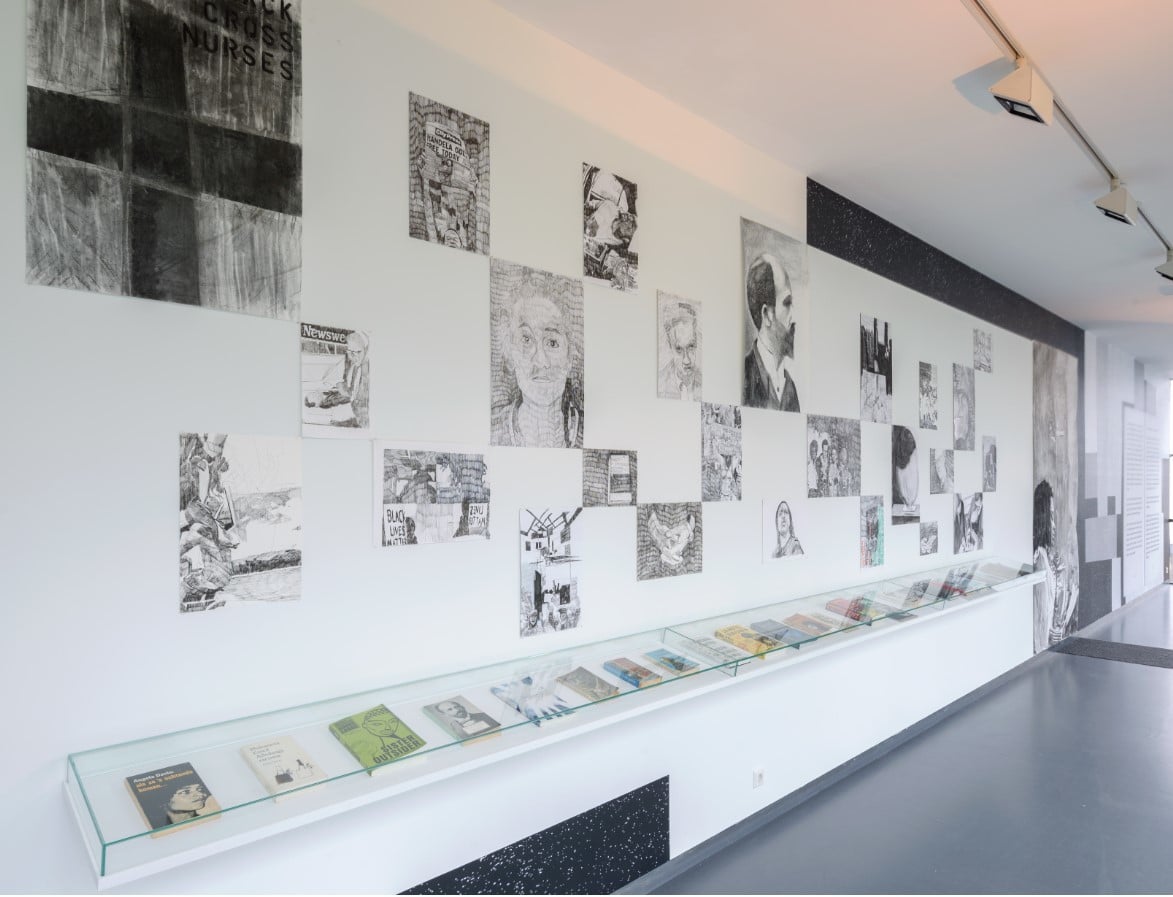 Study in Black Modernity, 2015-17, detail
Study in Black Modernity, 2015-17, detail© Collection Van Abbemuseum, Eindhoven / Peter Cox
Both in Breda and in Eindhoven Kensmil thus connects intellectual thought with contemporary discussions around discrimination and racism, not just in America and Suriname, but also in the Netherlands, where, in the words of Wekker, there is a gaping divide between the ‘dominant self-image and the realities experienced by people of colour.’ Through her portraits of anti-racist activists like the rapper Akwasi and performance artist Quinsy Gario, who play an important part in the Black Pete debate, Kensmil shows what postcolonialism means for a younger generation.
Kensmil’s depiction of certain peoples becomes embedded in a discourse around how what has happened in the past – colonial dominance – is connected to contemporary societal developments – racism and inequality. Kensmil’s oeuvre shines a light on that which flows from the wake of history and influences race and gender relations. By presenting these portraits in combination with abstract figurations that borrow from the Western art historical canon, Kensmil suggests that the art world, too, belongs to an system that sustains exclusion on the basis of race, origin and gender. The Western way of looking, thinking and evaluating – where ‘unpleasant’ truths become obscured – can be felt in all areas, daily interactions, and in the ways in which aesthetics are valued and the canon becomes organized.
(Non) political
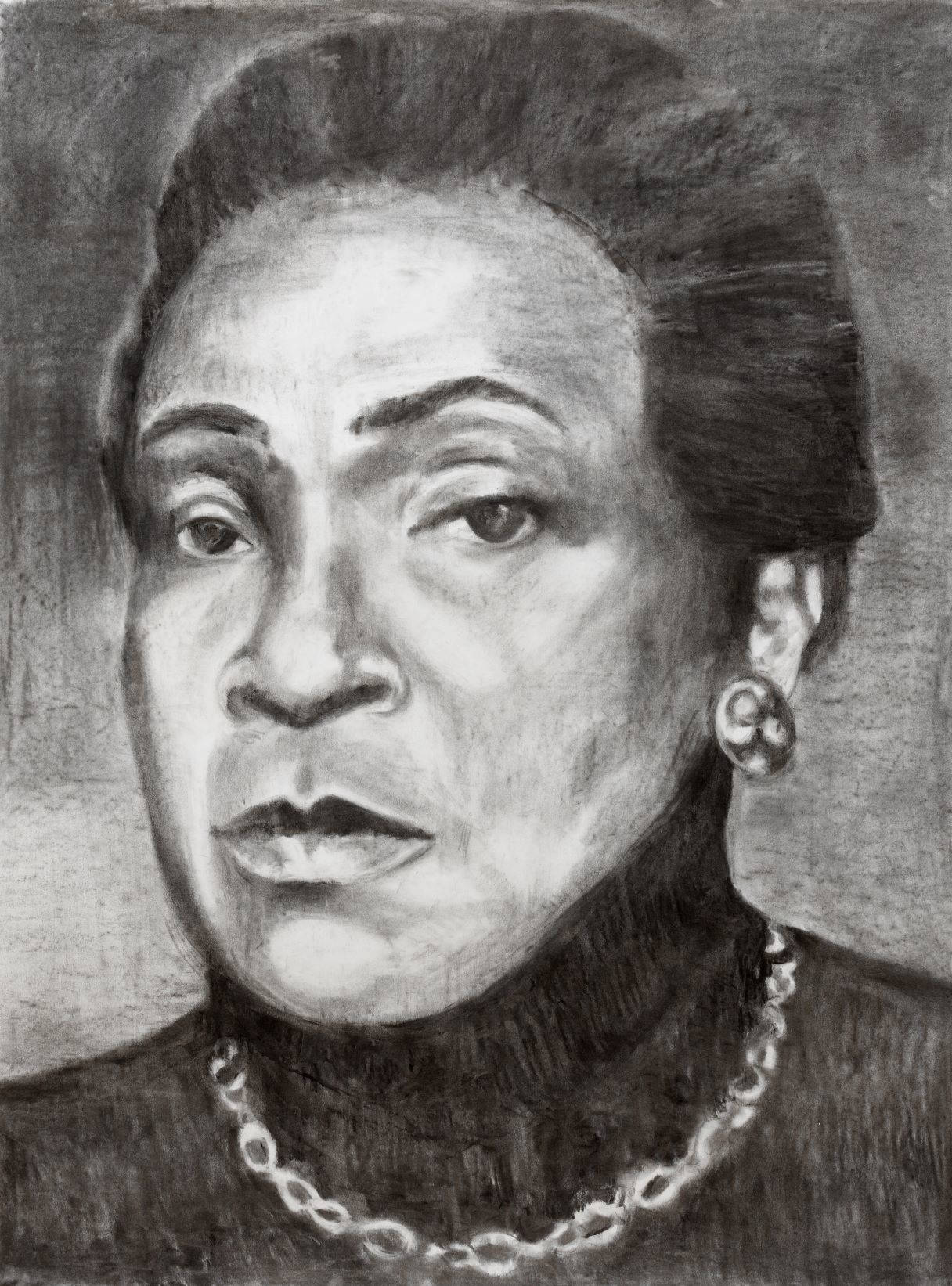 Study for Black Feminist #1, 2018
Study for Black Feminist #1, 2018© Gert Jan van Rooij
Kensmil’s work is part of a new, black awareness in the Netherlands that is expressed in articles like Black Art Matters. Black art in a changing society, the creation of the Black Renaissance Collective, the annual organizing of Black Achievement Month since 2016, and the conception of the Black Archives in Amsterdam in 2017. This is where Kensmil did her research for the Black Utopian Feminists
who express, through their work, an inspiring vision of the future.
Kensmil does not consider her work political. ‘For some people my work is confrontational, and confrontation is easily branded as political. However, I make my work from my own perspective on the world and aspire to represent influential characters as powerful as possible’, she says.
Yet she hopes that her portraits of those who resist unequal power structures and exclusionary systems, those who offer alternatives, will become of importance: to dismantle the stereotypical images of black women and men, but mostly in the hope of inspiring others, like she was inspired herself, to take notice of the richness and reach of black history.
iriskensmil.nl
Iris Kensmil – Blues Before Sunrise, until 13 April 2020, Museum Kranenburgh, Bergen, www.kranenburgh.nl












